Learning Standards for Mathematics
| Mathematical Reasoning | Number and Numeration |
|
1. Students use mathematical reasoning to analyze mathematical situations, make conjectures, gather evidence, and construct an argument. Students: • use models, facts, and relationships to draw conclusions about mathematics and explain their thinking. • use patterns and relationships to analyze mathematical situations. • justify their answers and solution processes. • use logical reasoning to reach simple conclusions. This is evident, for example, when students:  build geometric figures out of
straws. build geometric figures out of
straws. find patterns in sequences of
numbers, such as the triangular find patterns in sequences of
numbers, such as the triangularnumbers 1, 3, 6, 10, . . . .  explore number relationships
with a calculator (e.g., 12 + 6 = 18, explore number relationships
with a calculator (e.g., 12 + 6 = 18,11 + 7 = 18, etc.) and draw conclusions. |
2. Students use number sense and numeration to develop an understanding of the multiple uses of numbers in the real world, the use of numbers to communicate mathematically, and the use of numbers in the development of mathematical ideas. Students: • use whole numbers and fractions to identify locations, quantify groups of objects, and measure distances. • use concrete materials to model numbers and number relationships for whole numbers and common fractions, including decimal fractions. • relate counting to grouping and to place-value. • recognize the order of whole numbers and commonly used fractions and decimals. • demonstrate the concept of percent through problems related to actual situations. This is evident, for example, when students:  count out 15 small cubes and
exchange ten of the cubes for a rod count out 15 small cubes and
exchange ten of the cubes for a rodten cubes long.  use the number line to show the
position of 1/4. use the number line to show the
position of 1/4. figure the tax on $4.00 knowing that
taxes are 7 cents per $1.00. figure the tax on $4.00 knowing that
taxes are 7 cents per $1.00. |
Sample Problems
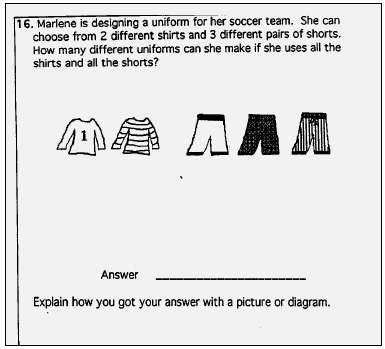
|
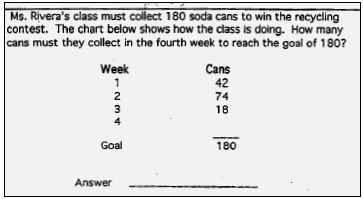 |
| Key ideas are identified by numbers
(1). Performance indicators are identified by bullets (•). Sample tasks are identified by triangles (  ). ). |
Students will understand mathematics and become
mathematically confident by
communicating and reasoning mathematically, by applying mathematics in
real-world settings, and by solving problems through the integrated study of
number systems, geometry, algebra, data analysis, probability, and trigonometry.
| Operations | Modeling/Multiple Representation |
| 3. Students use mathematical operations and relationships among them to understand mathematics. Students: • add, subtract, multiply, and divide whole numbers. • develop strategies for selecting the appropriate computational and operational method in problem-solving situations. • know single digit addition, subtraction, multiplication, and division facts. • understand the commutative and associative properties. This is evident, for example, when students:  use the fact that
multiplication is commutative use the fact that
multiplication is commutative(e.g., 2 x 7 = 7 x 2), to assist them with their memorizing of the basic facts.  solve multiple-step problems
that require at least two different solve multiple-step problems
that require at least two differentoperations.  progress from base ten blocks
to concrete models and then to progress from base ten blocks
to concrete models and then topaper and pencil algorithms. |
4. Students use mathematical modeling/multiple representation to provide a means of presenting, interpreting, communicating, and connecting mathematical information and relationships. Students: • use concrete materials to model spatial relationships. • construct tables, charts, and graphs to display and analyze real-world data. • use multiple representations (simulations, manipulative materials, pictures, and diagrams) as tools to explain the operation of everyday procedures. • use variables such as height, weight, and hand size to predict changes over time. • use physical materials, pictures, and diagrams to explain mathematical ideas and processes and to demonstrate geometric concepts. This is evident, for example, when students:  build a 3 x 3 x 3 cube out of
blocks. build a 3 x 3 x 3 cube out of
blocks. use square tiles to model
various rectangles with an area of 24 use square tiles to model
various rectangles with an area of 24square units.  read a bar graph of population
trends and write an explanation read a bar graph of population
trends and write an explanationof the information it contains. |
Sample Problems
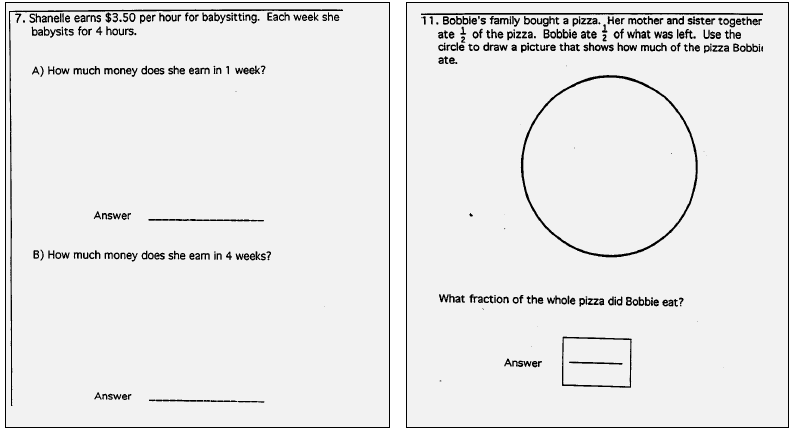
| Measurement | Uncertainty |
|
5. Students use measurement in both metric and English measure to provide a major link between the abstractions of mathematics and the real world in order to describe and compare objects and data. Students: • understand that measurement is approximate, never exact. • select appropriate standard and nonstandard measurement tools in measurement activities. • understand the attributes of area, length, capacity, weight, volume, time, temperature, and angle. • estimate and find measures such as length, perimeter, area, and volume using both nonstandard and standard units. • collect and display data. • use statistical methods such as graphs, tables, and charts to interpret data. This is evident, for example, when students:  measure with paper clips or
finger width. measure with paper clips or
finger width. estimate, then calculate, how
much paint would be needed to estimate, then calculate, how
much paint would be needed tocover one wall.  create a chart to display the
results of a survey conducted create a chart to display the
results of a survey conductedamong the classes in the school, or graph the amounts of survey responses by grade level. |
6. Students use ideas of uncertainty to
illustrate that mathematics involves more than exactness when dealing with everyday situations. Students: • make estimates to compare to actual results of both formal and informal measurement. • make estimates to compare to actual results of computations. • recognize situations where only an estimate is required. • develop a wide variety of estimation skills and strategies. • determine the reasonableness of results. • predict experimental probabilities. • make predictions using unbiased random samples. • determine probabilities of simple events. This is evident, for example, when students:  estimate the length of the
room before measuring. estimate the length of the
room before measuring. predict the average number of
red candies in a bag before predict the average number of
red candies in a bag beforeopening a group of bags, counting the candies, and then averaging the number that were red.  determine the probability of
picking an even numbered slip from determine the probability of
picking an even numbered slip froma hat containing slips of paper numbered 1, 2, 3, 4, 5, and 6. |
Sample Problems
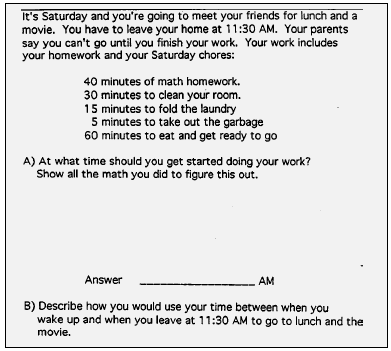 |
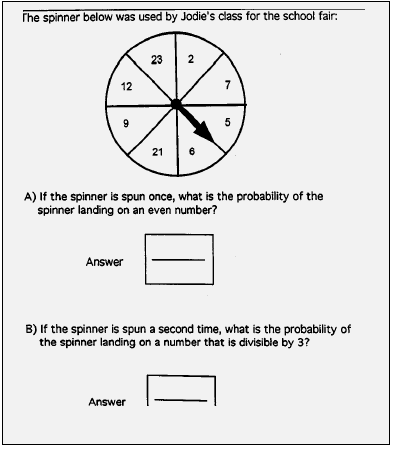
|
| Key ideas are identified by numbers
(1). Performance indicators are identified by bullets (•). Sample tasks are identified by triangles (  ). ). |
Students will understand mathematics and become
mathematically confident by
communicating and reasoning mathematically, by applying mathematics in
real-world settings, and by solving problems through the integrated study of
number systems, geometry, algebra, data analysis, probability, and trigonometry.
Patterns/Functions
7. Students use patterns and functions to develop
mathematical power, appreciate the true beauty of
mathematics, and construct generalizations that
describe patterns simply and efficiently.
Students:
• recognize, describe, extend, and create a wide variety of
patterns.
• represent and describe mathematical relationships.
• explore and express relationships using variables and
open sentences.
• solve for an unknown using manipulative materials.
• use a variety of manipulative materials and technologies
to explore patterns.
• interpret graphs.
• explore and develop relationships among two- and three-dimensional
geometric shapes.
• discover patterns in nature, art, music, and literature.
This is evident, for example, when students:
 represent three more than a number is equal
to nine as
represent three more than a number is equal
to nine as
n + 3 = 9.
 draw leaves, simple wallpaper patterns, or
write number
draw leaves, simple wallpaper patterns, or
write number
sequences to illustrate recurring patterns.
 write generalizations or conclusions from
display data in charts
write generalizations or conclusions from
display data in charts
or graphs.
Sample Problem



